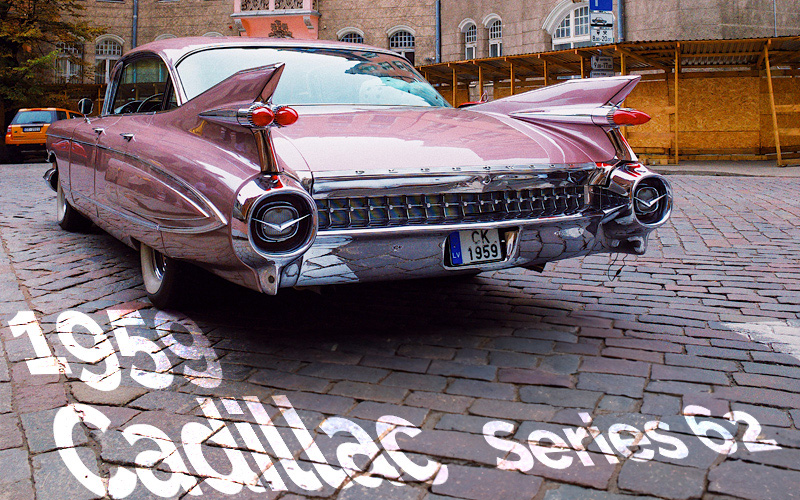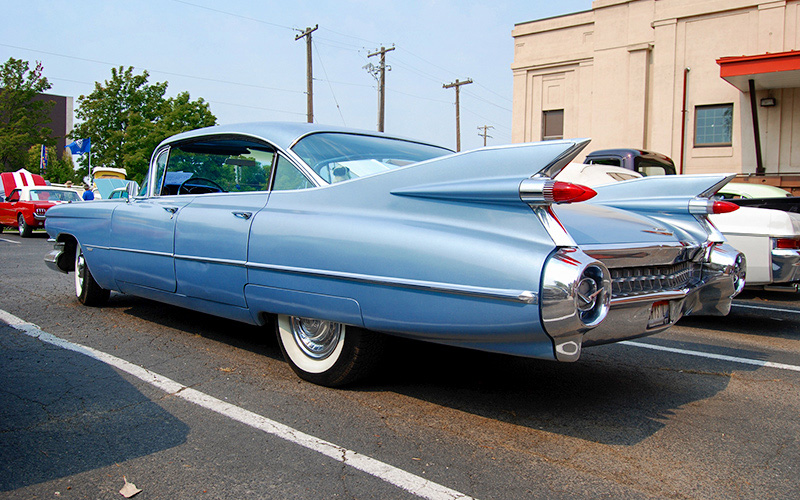At American Collectors Insurance, we don’t stop at offering great rates on great policies. Our classic car insurance policies provide broader protection and greater flexibility for your Cadillac. Receive a classic auto insurance quote in minutes to see how you can save.

The mighty 1959 Cadillac Series 62 and its showroom siblings were arguably the most outrageously styled full-sized hardtop sedans ever sold to the public. All body styles featured a tailfin silhouette that signified an entire era of automotive styling, it was so daring that the public couldn’t quite keep up. Perhaps consumers grew tired of ornamentation and theatrics in their sedans. Like it or not, however, the 1959 model year Cadillac secured a prominent place in automotive history.
The Road to 1959
By 1958, the entry-level Cadillac Series 62 had seen five generations of success – but the car’s design was starting to appear dull. Chrysler’s “forward look” cars were lower and more aggressive-looking, and though Cadillac had introduced tail fins in 1948, the fifth-generation Series 62 looked awfully conservative next to the astounding 1957 Chrysler Imperial. For the first time, General Motors would be playing catch-up in the design studio.
It came as no surprise that the 1959 Cadillac had a lot of “1957 Imperial” in it, particularly in the front fascia styling and altered proportions. 1959 was the first year that all full-sized cars at the GM would share the same basic platform. How could they compete with Imperial while using a platform that also had to serve Buick and Chevrolet – in particular, the front doors?
This unification of platform was good news of a sort at Chevrolet, which saw the Bel Air gain 11 inches of length for 1959. But it meant that Cadillac would have to find its visual excitement at the nose and tail of the car. Which, obviously, they did.

A Broad Range of Models
With the exception of the Fleetwood 75 sedan, which served the livery and corporate market, all 1959 Cadillacs featured a 225-inch body on a 130-inch wheelbase. An overhead-valve 390ci V8 engine provided more than enough power and was significantly stronger than the everyday V8s from Chevrolet and Ford. The transmission was a four-speed Hydra-Matic, no manual-shift models available. As was the practice at the time, coupe variants were a few hundred dollars cheaper, and the same roofline was used for the base model Series 62 ($4,892), Coupe de Ville ($5,252), and Eldorado Seville ($7,401). The 1959 Cadillac Series 62 convertible was available in the Sixty-Two ($5,455) and Eldorado Biarritz ($7,401) trims.
The sedan range was a bit more extensive – and here, ironically, Cadillac was trailing its lower-priced relatives at GM. The basic body shape was a 6-window sedan with a gracefully-curved roof, available as a Sixty-Two ($5,080), Sedan de Ville ($5,498), or Fleetwood Sixty Special ($6,233) with additional chrome detailing. For the same price, however, you could choose a “flat-top” 4-window sedan with wrap-around rear glass. It’s a bit easier to get into, but a bit harder to drive with a hat. Flat-top sedans were all the rage elsewhere in GM, but Cadillac was still conservative enough to offer the six-window as the default.
At the top of the range, the “Standard of The World” offered two very different vehicles. The Fleetwood 75 sedan offered formal styling and a 244.8-inch body on a 149.7-inch wheelbase. Just the thing for a long ride into the city. It sold at a base price of $9,533.

The 1959 Eldorado Brougham was something else entirely. It was the marriage of a Cadillac chassis and Pininfarina body, assembled in Italy then returned to the States. The price was astounding: $13,075 at a time when fully equipped Chevrolets could be had in the three-thousand-dollar range. But you did get a few unique benefits. The first, surely, was the absence of the 1959 GM front door, found everywhere from El Caminos to (other) Eldorados, which presented some unique challenges with regards to entry and exit. Another was more restrained styling that accurately foretold the 1961 Cadillacs to come. Just 99 were built, and not all have survived to the present day. (Not necessarily true – supposedly 100 were made, but one fell into the ocean while it was being loaded onto the ship back to the States!)
Exceptional Equipment
All Cadillacs were well-equipped featuring standard equipment such as power steering and power brakes to go with fender skirts and almost limitless chrome trim. Moving up to a de Ville got you power windows and two-way power seats. Eldorado models had all the options – cruise control, air suspension, power locks, Autronic Eye dimmer, tinted glass, whitewall tires, radio, air conditioning, six-way power seats, power decklid – standard, plus three 2-barrel Rochester carbs in place of a four-barrel Carter, yielding an additional 20 horsepower. This was, however, an option on all Cadillacs, and remarkably popular. A right-side mirror was available as a dealer-installed item, as were seat belts.
There was a broad variety of colors, with a preponderance of blue and green flanking two different whites, a few beiges and golds, and Seminole Red. There was no bright pink offered in 1959 – not that the lack of that option has stopped hundreds of owners from painting their fifty-nines in an eye-searing shade of it.
Modern car buyers will no doubt be shocked by the more than forty options for interior color and fabric, ranging from the subtle and professional (the light gray wool broadcloth front seats and dark grey corduroy rear seats of Fleetwood 75 sedans) to the flat outrageous (leather interiors in turquoise, bronze, and bright green).
Inspiring The Future
Customer reaction to the 1959 Cadillac was mixed, but the general consensus was that the exaggerated tailfins with their dual-jet-nozzle lights were simply a bridge too far. Bill Mitchell tidied the car up a bit for 1960, bringing it closer to the restrained look of the 1959 Eldorado Brougham. For 1961, Cadillac would tone down the wraparound windshield and lower the tailfins – but the 1961 Lincoln Continental made it look stodgy, and Cadillac would play catch-up until the early Seventies.

Although it wasn’t obvious at the time, the 1959 Cadillac Series 62 did set one major, and lasting, trend, namely: the “slab side” styling that was necessary to work with the universal GM front door. When comparing a 1959 Cadillac to its 1958 predecessor, it’s immediately obvious just how modern the sheet metal between the fins and the fenders looks. It put an end to the various coves and hollows and “flame surfacing” – or at least it did until BMW resurrected the idea at the turn of the 21st century!
You can still find the famous tail fins of the ‘59 Cadillac at diners, on postcards, in art meant to evoke the Fifties, and in much of the Route 66 mythology that has arisen over the past few decades. In many ways, the car was a dead end; never again would a Cadillac, or any GM sedan, offer quite this level of styling excitement. But it was also a sort of permanent high-water mark, a car that will never be forgotten and will continue to captivate the eye long after its more practical ancestors and successors have faded. They’re still hugely popular in the classic and collector car market, thanks to their mechanical simplicity and durable construction as much as their looks. It was the maximum Cadillac – and it still is.

Leave A Comment